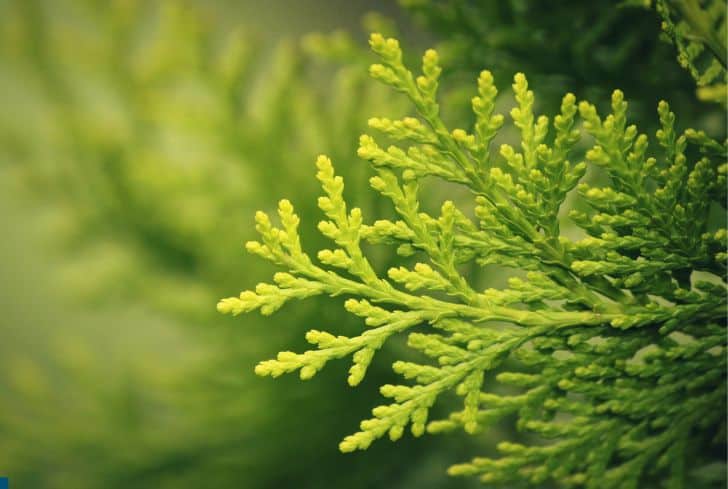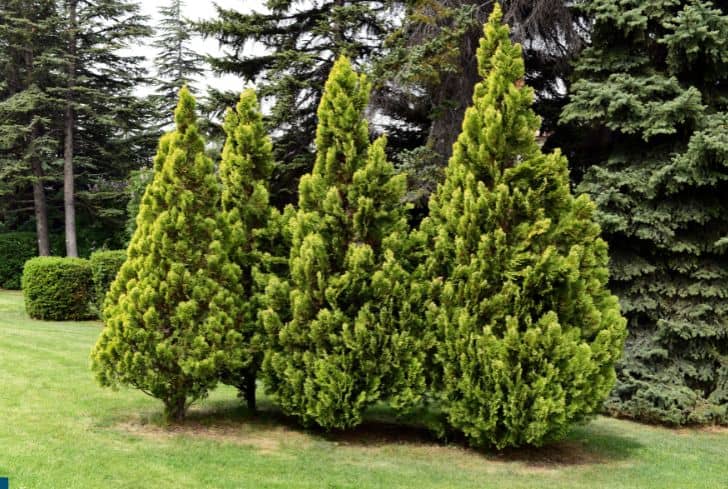Arborvitae is a unique, decorative tree popularly used as hedges, windbreaks, and privacy screens. This stunning evergreen is a low-maintenance plant that is great for beginners and experienced plant lovers alike. And while it’s a very strong and hardy tree, proper watering is essential to keep it healthy and attractive.
But then, even the best of gardeners make mistakes when it comes to watering this drought-tolerant tree. While some gardeners give it too much water, others forget to water their Arborvitae.
If you’ve made any of these watering mistakes and your Arborvitae is turning brown, you can take a few steps to fix the issue. Here, you’ll learn how to save an overwatered Arborvitae and how to water your Arborvitae properly in the future.
Can You Overwater Arborvitae?
Yes, Arborvitae can be overwatered but it isn’t recommended. Although Arborvitae is more tolerant of moist soil than most evergreens, overwatered and poorly drained soil will cause the plant to drown. As such, keep the soil moist but not soggy or waterlogged.
Overwatering can be very damaging to this decorative tree. It can make the roots to rot, and the plant to become more prone to infection.
Hence, if you want your Arborvitae to have a well-developed root system and grow nicely into the ornamental piece you want for your yard, avoid overwatering it, especially for the younger plants.
How do I Know if my Arborvitae is Overwatered or Needs Water?
There are several ways to identify an overwatered or underwatered Arborvitae. If your Arborvitae tree has been overwatered, you’ll observe the following symptoms:
- Discoloration of leaves: The foliage turns yellow or brown, mostly on the younger exterior part of the plant.
- Leaf dieback: This may occur on some parts of your tree, such as the tip of the foliage.
- Wet soil: An overwatered Arborvitae would have an overly moist/saturated soil, especially around the roots.
That’s for overwatering.
You can tell that your Arborvitae tree needs water if you notice these symptoms:
- Discoloration of leaves: Yellowing and browning of exterior leaves is one of the signs that your plant needs water. It is different from the browning of interior leaves in fall due to aging.
- Overall plant weakness: When the tree is underwatered, it loses vigor due to a lack of water and nutrients necessary for growth.
- Dropping of leaves: Normally, Arborvitae leaves also drop naturally in autumn, but if you observe an unusual leaf dropping that goes beyond this, it could be a sign of underwatering.
- Dry soil: The topsoil of an underwatered Arborvitae would have a pale, dry look and feel.
For Arborvitae trees, overwatering and underwatering have some similar symptoms. This can be very tricky, so you’ll need to be cautious and check your plant soil to be certain that your plant has been overwatered or underwatered.
Oftentimes, merely checking the topsoil will not help you tell correctly if your soil has been overwatered or needs water. If your Arborvitae is just newly planted, you can use a long screwdriver or perform a simple finger test by dipping it a few inches into the soil to check if it is dry or soaked.
For giant Arborvitae, you may need to dig a small hole down to 10 inches deep on the outer corners of your soil. If it’s still very wet or soaked in water, your Arborvitae is overwatered. But if the soil is dry with a pale appearance, then it could be that water doesn’t get to the tree’s roots, and your plant is in dire need of a drink.
How to Save an Overwatered Arborvitae?
If you’ve accidentally overwatered your Arborvitae, stop watering and let the soil dry before you water again. Overwatered Arborvitae trees normally attract fungi, bacteria, and other nuisances. So you may also have to deal with fungal diseases if you’ve left your plant to sit in water for long.
Here are a few steps you should follow to save overwatered Arborvitae:
1. Stop Watering and Let Your Plant Soil Dry Up
The first step you want to take to save an overwatered Arborvitae is to stop watering it immediately. Once you discover that your tree is overwatered and struggling to breathe and survive, stop watering it temporarily to allow the soil to dry up.
Leave your Arborvitae and let it dry for 7-21 days, depending on how much you have overwatered it. You’ll need to be proactive and check the soil from time to time using the finger test or a moisture meter to know when it has dried up so you can start watering again.
2. Loosen and Aerate Your Soil
This is something you’ll want to do to your soil to improve the supply of oxygen and nutrients to your tree. Overwatering makes the soil compact, leaving little or no space for sufficient oxygen to reach the roots.
Aerating your soil would help it dry out and create space for the easy flow of oxygen to the roots. The simplest way to loosen and aerate your soil is by digging and turning it over with a pitchfork. This will break up and create space between the compacted soil particles.
3. Adjust Your Soil
An overwatered Arborvitae is often a sign of a much bigger issue – poor soil drainage. A well-draining soil retains just enough moisture for your plant.
If you’ve already planted Arborvitae in poorly-draining soil, you can amend it by adding mulch to the topsoil or elevating the soil with hilling. The latter option helps prevent waterlogging even when it rains. You’ll only need a shovel to make a hill with the soil.
4. Water Arborvitae Properly
To ensure you don’t have to go through this trouble again, water your Arborvitae properly, as described below in this article. Also, inspect your Arborvitae after it rains to discover where the rainwater is pooling.
Check if the water is moving downhill nicely, collecting at the base of the tree, or if a rain downspout is emptied close to your Arborvitae and adjust it.

How Much Water Does Arborvitae Need?
Arborvitae need to be watered deeply and thoroughly. But ensure you’ve planted it in well-draining soil. For Arborvitae trees, deep soaks are preferable to ensure the water gets to the roots. So, for larger Arborvitae trees, about 10 gallons or 37.85 liters of water per inch of the tree’s diameter is recommended.
You’ll need to do enough watering to keep the soil moist but not soggy. Also, remember that Arborvitae becomes fairly drought-tolerant once it is established, so they wouldn’t need to be watered as often as younger trees.
If you’re in hot weather, you’ll need to water your Arborvitae more to maintain the soil moisture content. And as the weather cools down, you might not be required to water as much again.
To ensure you have given Arborvitae enough water, you’ll want to ensure there is moisture five inches deep into the soil using your finger.
How Often Should You Water Newly Planted Arborvitae?
Arborvitae is evergreen, so most people ignore their plant until it starts turning brown. Newly planted trees require more attention and water than already established ones. For the entire first season after planting, give your Arborvitae tree a deep soaking to remove air pockets in the soil.
A weekly soaking is better for your newly planted Arborvitae during the first week than daily splashes that don’t reach the roots. If you live in areas with intense heat, you can consider giving your young plant a deep soaking twice weekly. It will suffice just fine.
So sprinklers are not as effective as soaker hoses when watering your newly planted Arborvitae. After the first week, continue to offer deep soaking that will penetrate the root balls weekly. If you’ve planted it in a container, water it at least once every two days, especially when planted in sandy soil or when the weather is very hot.
The best time to water Arborvitae is in the mornings. But you should check your plant and water when it needs it. To conserve moisture, especially in very cold seasons, add a layer of mulch to the soil.
Newly Planted Arborvitae Turning Brown: What to Do?
The most likely reason for the browning of the leaves in a newly planted Arborvitae tree is transplant shock. Arborvitae trees often suffer from transplant shock because of the stress and damage caused to their roots during the transplant.
The damage prevents the proper uptake of water and nutrients to the entire plant, causing the browning and wilting of your Arborvitae leaves, especially at the tips.
You can successfully revive your Arborvitae after a transplant shock, but it’ll take years before it completely recovers. Below are a few tips to help you deal with transplant shock:
- Water your tree adequately and regularly as discussed above.
- Avoid moving or transplanting your Arborvitae tree for at least one or two seasons to prevent further stress on your plant.
- Do not fertilize your newly planted Arborvitae for at least ten to twelve months, simply apply a deep layer of mulch a few inches away from the tree trunk
- Pruning your Arborvitae can stress it. Only prune when necessary (to remove dead or decaying parts).
Other common reasons why young Arborvitae trees turn brown include:
- Underwatering
- Overwatering
- Extreme weather conditions
- Winter burn
- Fungal diseases
Some of the ways to prevent these issues include:
- Water your plant frequently, especially during summer and fall.
- Prevent winter burn by wrapping your Arborvitae in burlap or planting in a location that is sheltered from harsh wind and freezing weather in winter.
- Prune Arborvitae in spring or summer to boost plant health and encourage growth.
- Plant Arborvitae in well-draining soil to prevent soggy roots and fungal diseases.






